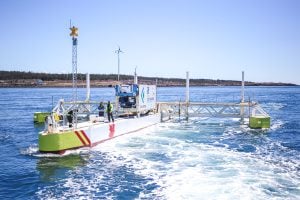
Environment
The truth about carbon capture
Carbon capture is big business, but its challenges fly in the face of the need to lower emissions. Can we square the circle on this technological Wild West?
- 5042 words
- 21 minutes
This article is over 5 years old and may contain outdated information.
Science & Tech

Chris Henderson is the author of Aboriginal Power and president of Lumos Energy Clean Energy Value Advisors Inc. He advises indigenous communities across the country on clean energy. Henderson is speaking at the Energy Council of Canada’s 2015 Canadian Energy Summit in Toronto, and talks here about the impact clean energy project partnerships are having on Canada’s aboriginal communities.
How do aboriginals fit into Canada’s energy story?
Every square inch of Canadian soil was traditionally indigenous territory. Most of that is still crown land. From a legal perspective, you can’t develop that without some manner of aboriginal support.
As far as clean energy project partnerships go, what we want to do is make the pie bigger. This isn’t a case of taking anything away from partners or from the public itself. Having aboriginal participation makes the project move much faster, cheaper, better. They help shape the project, they make sure environmental factors and local knowledge are considered and community engagement is more robust. As an investor, they have benefits that they can use for long-term community benefits. If you want to do a project on non-private land, having an aboriginal partner is going to ensure that it’s a much better project overall, and might even ensure that you have a project.
How does aboriginal partnerships on projects impact non-aboriginal members of society?
We need to remember that most of these projects are proposed by private partners. So at the end of the day, would you like 70% of the revenue of a project that goes ahead, or 100% of a project that doesn’t happen. Wouldn’t it be better for society if aboriginal communities, many of which have to rely heavily on taxpayer support, could become participating members of the economy? Every Canadian I know would agree to that. This isn’t a loss–it’s a huge win for the average Canadian.
What has to happen for us to move in that direction? How does Lumos help?
Well there’s a lot that’s happening now, and a lot that’s already happened. There are about 60 medium to large scale projects (each worth between 50 million and 70 billion dollars) in Canada that are operating today that are owned in part or entirely by Aboriginal communities. And there are probably another 100 yet to come. Even if only a few of them are built, you’re still seeing a lot of money in clean energy projects. So what’s been working? Aboriginal communities have had champions. There’s been someone who has said, let’s make this happen. In terms of policy, look at the provinces. Ontario has a series of programs that support aboriginal involvement. Their leadership development needs to be strengthened. Through Lumos I work as an active advisor to them. I’ve aligned my interests 100% with the community. I don’t earn any sort of consulting fee; I get money when the project is confirmed. Finally, I help the aboriginal communities organize their revenue to help structure their community legacy and build the social and economic foundation for future generations. To my mind, this is a story that’s already been written.
What kind of impact these projects have on the aboriginal communities?
Each time, involvement in the projects become more substantive. The revenues are invested back in the community and used to build a lively and resilient community that’s walking proudly into the future. Doing a clean energy project is not easy. But once they’re done, they’re done for decades. If you open a hotel, you need people to stay at that hotel to be profitable. But once you set up a clean energy project, you now have a flow of income to give you the time and space to refocus inwards.
Any misconceptions you’d like to clear up about aboriginal involvement in clean energy projects?
It’s entirely reasonable to weigh alternatives, but you have to consider all the costs, all the benefits. Renewable offers you a better deal over time. Most of the money is put down at the outset, but renewable energy costs are also getting lower. A misconception about aboriginal involvement is that they’re getting a free ride. Frankly that’s a bunch of hooey. It’s their land, and if the resources are going to be used, they’re looking for an opportunity to invest. Aboriginal communities have all the acumen and interest to be valuable partners.
How do you see this story ending?
Aboriginal participation in clean energy projects will be the single largest force that will allow our aboriginal communities to gain economic independence. That’s the story we’re writing.
Are you passionate about Canadian geography?
You can support Canadian Geographic in 3 ways:

Environment
Carbon capture is big business, but its challenges fly in the face of the need to lower emissions. Can we square the circle on this technological Wild West?

Science & Tech
In the Bay of Fundy, technicians are putting a groundbreaking new tidal technology through its paces

Science & Tech
Where and how we live affect how much energy we consume. Here’s what Canada would look like if the provinces and territories were scaled to represent the amount of energy they use.

Science & Tech
Part two of Canada’s Ocean Supercluster: A six-part series